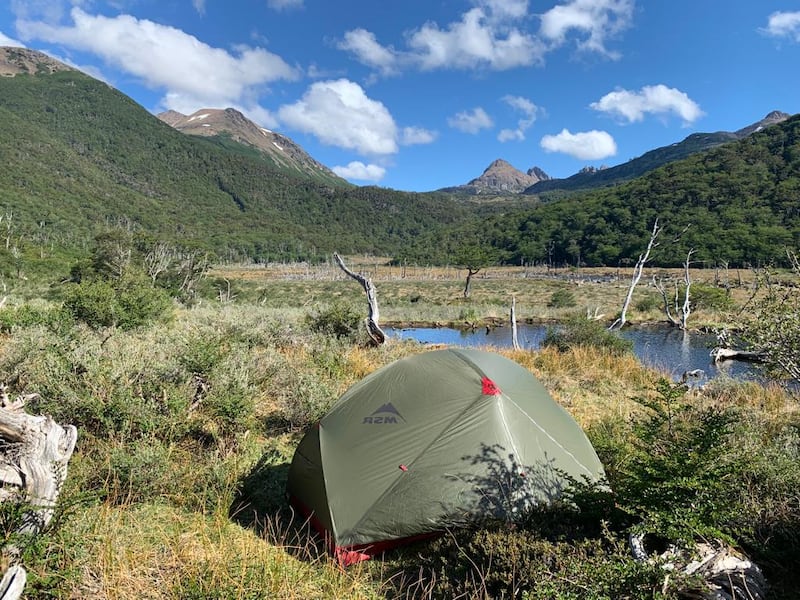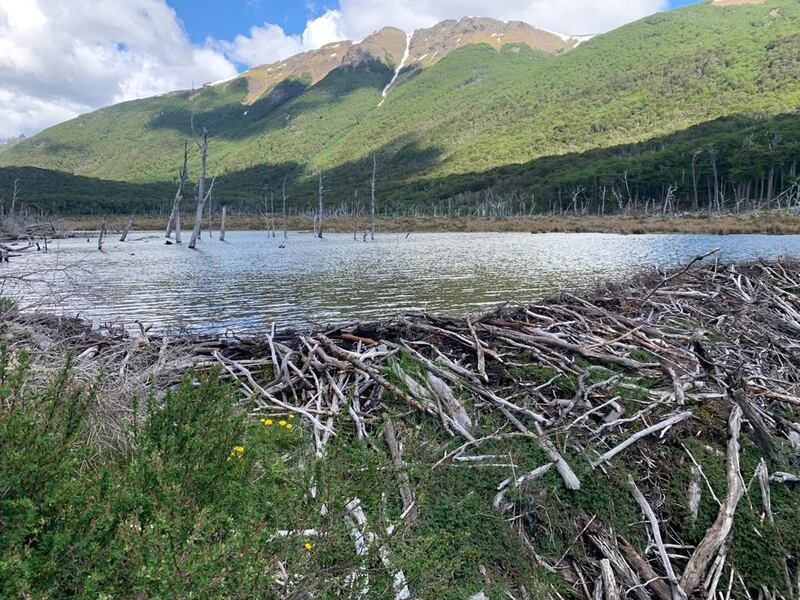Ferry rides are generally perfunctory affairs. You get on board and do what you have to do to get through the tedium of the journey – play cards, fill in crosswords, read a book, whatever. Except when you’re on the Austral Broom’s Yangan from Punta Arenas to Puerto Williams, the place farthest south in Chile that it is practicable for me to go, south of Argentina’s Ushuaia, the better-known “most southern town in the world”, which it really isn’t. You don’t need distractions on this trip because there’s just way too much to see: epic seascapes churned up by the austral winds, sea birds performing aerobatics over the waves, raw and edgy landscapes and placenames straight out of childhood adventure stories and geography class.
We set sail down the Strait of Magellan at about six in the evening, passing Cape Froward and its lighthouse, the final tip of the continental land mass of South America. In the far distance, in the fading gunmetal light of the night sky, we can just about make out the snow-capped mountains of the various islands that make up the network of land and sea channels that are the toe-shaped formation of Tierra del Fuego and Cape Horn.
Not for no reason did Bruce Chatwin describe the strait as a case of nature imitating art.
The Yangan is a workhorse. A giant version of the sort of landing craft used on D-Day, with a bow door that opens down, creating a slipway for vehicles. Primarily a cargo vessel that also caters for passengers, its deck is crammed with containers, vans and four-wheel drives, oil drums, wooden pallets, a dozen tonne bags of cement, lengths of steel and mesh for fencing. And now also my bike.
During the night, the ship threads its way south like a darning needle, passing between islands and through channels, the names of which tell the story of the discovery of this place from the 16th to the 19th centuries. We avoid fully entering the Pacific, passing instead on the inside of Isla London and into the Ballenero Channel, north of the islands of Stewart, Gilbert and Londonderry. The channel is squeezed narrow as it passes between Londonderry to the south and O’Brien Island to the north, before passing Darwin Island and entering the Darwin Channel.

North of us is Tierra del Fuego and the dark, brooding mountain range the Cordillera Darwin – a set of snow-capped peaks, glacier tongues flowing off them but not quite dipping into the sea. I suspect they once did, before global warming began to eat away at them, as is evident from photographs taken a mere decade ago.
The ferry moves slowly, providing passengers, some locals and also some tourists (from France, Italy, the Far East and the United States) with ample time to take in the sights. The islands’ scenery is truly breathtaking. Gigantic in scale and inhospitable in nature, the weather-beaten land masses are a shade of deep grey just short of black, the peaks white and their flanks broken by blotches of snow above the tree line. Despite some vegetation and forestry, there is no visible evidence of habitation.

Sea birds abound but the star performer by a long shot is the petrel. Often flying solo, the bird moves upwards in graceful arcs, falling down again to the water, to glide, at great speed and with seeming effortlessness, its wing tips almost brushing the tops of the waves.
We enter the Beagle Channel separating Chile and Argentina and dock at Puerto Williams around midnight. Foot passengers alight but all the cargo stays put, my bike included. “Manaña,” says a crew member, adding not to worry, that I can sleep on the boat.

Next day, I park the bike immediately outside the Refugio el Padrino, a hostel beside the harbour, but have to move it almost at once. I am, apparently, taking up Cecelia’s place – Cecelia, another larger-than-life hospitalera, who greets me like an over-the-top diva, proffering both cheeks for a kiss and administering a warm hug at the same time. Come in, come in, she insists, telling me that I am to have eggs and cheese and bread and coffee and then we will discuss matters. Sit, she commands, and who am I to question her?
The hostel kitchen-cum-livingroom is typical of the kind – an amiable clutter of posters, maps, photographs and flags, and a beaver pelt nailed flat on to the wall. The place is named in honour of Eduardo Mancilla Vera, an otter and sea lion hunter who came to Puerto Williams in the 1940s and stayed until his death aged 81 in 2003. He spent his life helping to create the town and championing its cause, lobbying the authorities for more, and was so respected by the inhabitants that many of them named him as godfather to their children – hence his nickname: El Padrino, the Godfather. Eduardo is Cecelia’s father.
Puerto Williams has a real pioneer town feel to it – gritty, dusty and unkempt; some roads are concrete but most are just compacted dirt and gravel. They kick up dust when a vehicle passes. The original houses, those closest to the harbour, have a rundown, paint-peeling shanty appearance to them. They are jumbles of plywood and sheet metal, often with satellite dishes nailed on the fronts. Gardens, as generally understood, are virtually non-existent. The areas in front of and around the homes are parking lots and places for piles of timber, chopping blocks and other stuff. There are dogs everywhere.
Many other homes farther back from the harbour are owned by the Chilean navy and are better kept. The best buildings in the town are invariably associated with government. Puerto Williams as a town didn’t come into being formally until November 1953, the year of my birth and an anniversary to be marked the next day.
For now, however, I attempt my trek across the island to Lago Windhond, which is about 25km directly south and where there is a shack, the Refugio Charles, the most southerly place where I can sleep, before turning north and heading for Alaska, some 30,000km away – my bottom-most tip in this Tip2Top adventure.

I set off down the Ukika river valley, through dense woods, on a trail marked by two parallel red lines on a white background painted on to tree trunks. My compass bearing shows exactly 190 degrees, pointing precisely south. But after perhaps 4km, the trail marker signs disappear and soon I become hopelessly lost. For now, I’m able to confirm my direction not just by my map and compass, but also by following the skyline of the mountain ridges on their side of the valley.
What should be a simple enough trek with these aids becomes more and more difficult as the woods thicken and fallen trunks and debris slow progress to a painful crawl. An ant would make faster progress through a ball of wire wool. I become increasingly concerned that if anything untoward happens, a fall, a sprain or, worse, a break, no one would know where to find me, because there is no trail as such, so how could they find me?
Forward movement becomes more and more arduous and, having zigzagged up and down the side of the valley, trying to relocate the trail, I descend to the valley floor. If nature does dystopia, this is maybe close to it. While it looks beautiful, the area is strewn with timber wreckage created by beavers, chomping away at everything in their path. The entire valley floor is a maze of dams, lakes and swamp, of gnawed-off stumps and timber debris. Any trees left standing are dead and the whole landscape looks not unlike No Man’s Land circa 1918.
By 4pm, after some five hours’ hiking, I have covered only about 12km – half the distance to the lake. I decide to give up and pitch my tent where I am – on a dry mound sandwiched between the forest and the swamp. I will sleep with the beavers, I think to myself. At night, however, all I hear is the sound of bats and of wild barking dogs, four or five of them farther up the valley – where no one lives...

I awake to find a lone goose, an avutarda, a grey-headed fellow with a lovely rust-coloured chest, standing by the beaver lake, just feet away. We size each other up for a few moments before he waddles off, unfazed by my presence. I decide not to risk further trekking alone and, knowing the river will reach the sea, start to follow it downstream. Wild horses had done the same and conveniently flattened out a path – not to Lake Windhond, unfortunately, but back to the port.
Next day, back in Puerto Williams, they’re getting ready in Plaza Bernardo O’Higgins to mark the town’s 69th birthday. The school band, the Banda de Guerra, leads the parade, followed by a marching column of about 60 naval ratings and a dozen or so officers, who are formally inspected by the regional governor, Jorge Flies, and the commander of the navy’s Beagle Channel operation, Comdt Cristián Yáñez.
Flags of the town, the region and the state are raised and the national anthem is sung. The governor and the mayor, Patricio Fernández, make the sort of speeches governors and mayors make on such occasions – praising the people and their town for all they have accomplished and the bright future that awaits them. Medals are presented to naval servicemen and local worthies; kindergarten and school children parade.
Wearing a Sandeman port-style broad-brimmed black hat, poncho and black leather boots with spurs, traditional Chilean dancer Pablo Suaso leads his troupe through several foot-stomping, skirt-and-handkerchief-swirling numbers by the bust of Bernardo O’Higgins, Chile’s liberator from Spanish rule.
“My hero,” says Pablo when I chat to him.
Bernardo O’Higgins was the illegitimate son of Ambrose O’Higgins, a merchant prince made governor of Chile in 1788, late of Sligo and Meath.
Peter Murtagh will be writing about his trip regularly as well as blogging on his own website, Tip2Top.ie. You may follow him there and also on Instagram (Tip2Topadventure), Facebook (Peter Murtagh) and Twitter (@PeterMurtagh)












